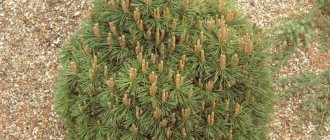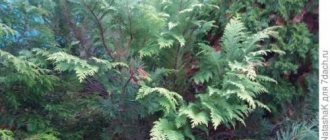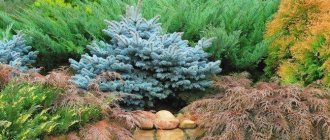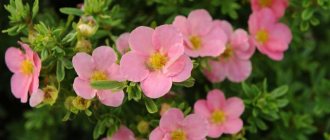- September 1, 2018
- Trees and shrubs
- Lidiya Sherstova
Mountain pine Pumilio (lat. Pinus mugo var. Pumilio) is a popular decorative dwarf coniferous shrub with a creeping crown. It is a natural species of Pinus mugo, a ten-metre tall tree native to the mountains of central and southern Europe. In gardening, Pumilio is included in the list of the most common dwarf varieties of mountain pine. This shrub is very often used in landscape design.
Due to the creeping shape of the crown, the mountain pine Pumilio is otherwise called dwarf cedar. The decorative version of this shrub is the result of selective selection of the shortest and slowest growing specimens of Pinus mugo.
Botanical description of the mountain pine Pumilio
Unlike mountain pine varieties of purely selective origin, Pumilio can be found in natural conditions. Its distribution area is located at an altitude of 2600 meters above sea level and is confined to the subalpine and alpine belts of the Carpathians, Balkans and Alps.
The height of the mountain pine Pumilio does not exceed one and a half meters. The crown diameter is relatively wide (up to 3 m). Over the course of a year, the bush grows 5 cm in height and 12 cm in width. When describing the Pumilio pine, the shape and structure of the crown occupy a special place. It is these characteristics that most clearly reflect the decorative value of the plant.
Shoots of Pinus mugo var. Pumilio develop in two directions - horizontal and vertical, forming a dense, spreading crown of a creeping type with a towering dense dome. At the same time, the branches are located very close to each other, so in the photo the Pumilio mountain pine looks like a solid flat-rounded or cushion-shaped formation with a neat patterned surface. The absence of large clearings between the shoots gives the plant an elegant decorative appearance. And yet, to give the crown the desired degree of density, pine requires pruning.

The evergreen needles of Pumilio are predominantly short (length varies from 3 to 5 cm), located on the branches in the form of tightly adjacent bunches, each of which contains two hard dark green needles (young shoots are lighter). The gray-brown bark of mountain pine has a scaly structure and gradually peels off. The needles do not fall off for a long time (up to 5 years).
On the lush crown, buds and dark brown, almost sessile, symmetrical cones of an ovoid or broadly ovoid shape are clearly visible. The length of the cones varies from 2 to 5 cm. The seed reproductive system of Pumilio begins to function by 6-8 years of life.
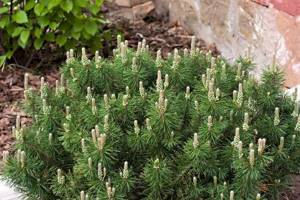
Reproduction
There are several ways to propagate miniature pine: grafting, through seeds or cuttings.
If you are not a professional in this matter, the best option is to use seeds (it is quite possible to collect them yourself). This approach allows you to completely preserve the decorative nature of the mother tree and is almost always crowned with success.
Seed material is collected in November at the end of the pollination process. Subsequently, they are subjected to stratification for 4-5 months. Seed germination is about 35% of the total amount.
First of all, the prepared seeds are planted in a light soil mixture and its moisture is constantly monitored. When sprouts appear, they are planted in separate containers and kept at home for 4-5 years.
In the case of propagation through cuttings, young shoots are used, on which a heel is left - part of the bark of the mother tree. They are first placed in water for a couple of hours, then kept in a preparation to stimulate growth. Then they are planted in the ground, planted to a depth of 5 cm.
Additionally, greenhouse conditions are created. A cushion of manure is considered useful, as it provides the delicate plant with the necessary warmth.
The grafting method is the least successful. For this purpose, 1-3 year old shoots are grafted onto seedlings that are 4-5 years old.
Practical use
The decorative uses of mountain Pumilio pine are very diverse. It is used for landscaping gardens, parks, personal plots, and creating undergrowth. The nature of planting can be either single or group.
The use of mountain pine Pumilio in landscape design is very popular. In the photo, this bush looks like a very compact and elegant plant that can fit perfectly into many compositions without disturbing the surrounding landscape. This decorative property is successfully manipulated by designers when creating mixed groups. Pine looks good on the lawn, in rockeries, as well as in heather and Japanese gardens. Pumilio is very convenient for forming coniferous borders.
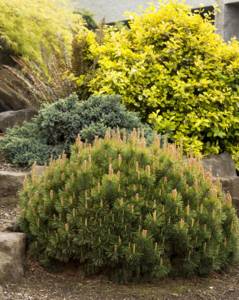
Dwarf mountain pine is so tiny that it can even be grown in containers and used for landscaping various infrastructure elements (terraces, roofs, small courtyards, balconies, patios, etc.) It takes the bush as much as 30 years to reach a height of 1 meter.
Despite the slow growth and small size of the crown, Pumilio has not only decorative, but also technical applications. Due to its extraordinary spicy-woody aroma, its needles are the best raw material for the production of perfume pine oil.
Pine Mugo Pumilio - description of the plant
Mugo Pumilio pine (Pinus Mugo Pumilio) or as it is also called mountain pine is an evergreen overgrown small shrub. It has a fairly dense crown. It reaches a maximum height of 1.5 meters, and a diameter of 2.5 - 3 m.
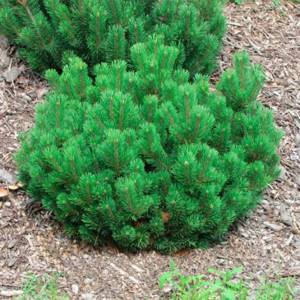
Pine Mugo Pumilio (Pinus Mugo Pumilio) - photo
The needles are rich green. The needles are sharp, 2–3 cm in length. The cones are cone-shaped, brown in color, their length reaches 4 cm. Fruiting begins after 7 years. The shoots are directed upward and thereby create a dome.
This pine is widespread in the mountains of Central and Eastern Europe.
This plant loves the sun very much and does not tolerate dark places, but despite this it is frost-resistant.
It grows equally in both acidic and alkaline environments. Feels good in urban conditions.
In the first few years after planting, it is recommended to protect the plant from sunlight in winter and spring with burlap. This shrub is quite reliable and easy to care for and can decorate absolutely any garden.
Use in landscape design
The incomparable advantage of using mountain pine Pumilio in landscape design is that, unlike other conifers, it does not affect neighboring plants in any way. In addition, the compactness and neat appearance of this shrub create conditions for creating various compositions. Pumilio does not take up much space and goes well with both other conifers and flowering plants. This shrub can be used as a decorative background or to fill soil voids.
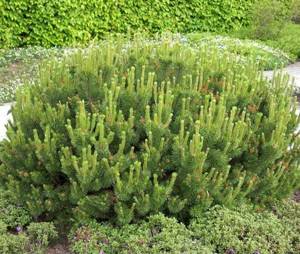
To create a mixed plant landscape, Pumilio mountain pine goes well with:
- plants with beautiful decorative foliage;
- maple seedlings;
- heather and cereal plants;
- lushly flowering shrubs;
- herbaceous plants and other conifers.
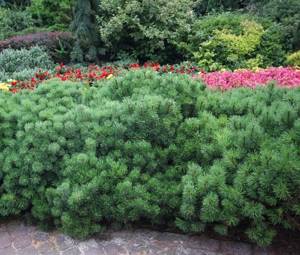
Thanks to Pumilio's tolerance to soil composition and structure, it can be planted on almost any soil, including embankments and rocky slopes. However, when creating compositions, it is necessary to take into account that this shrub grows well only in illuminated areas and does not take root well in the shade.
Most often, mountain pine Pumilio is planted to create hedges or in flower beds. This dwarf coniferous plant looks especially beautiful against the background of small stones.
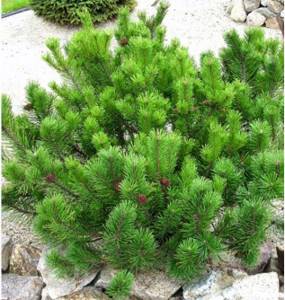
Care
Pinus Pumilio is not picky about the level of soil moisture or its composition. It can grow with equal success both in private plots and within the city due to its immunity to air pollution.
For comfortable growth of shrubs, it is enough to adhere to certain points in agrotechnical work that will not cause difficulties in their implementation.
Watering
An adult Pumilio pine, unlike a seedling, is quite calm about drought. The shrub requires watering only for the first month if planted in the autumn or throughout the entire season if this happened in the spring.
In order to ensure a comfortable wintering, the plant must be well moistened in the fall. Water the pine tree in several approaches so that the moisture penetrates deeply into the soil.
Feeding
This conifer is not a variety, but a subspecies, and after being removed from its natural range, it was practically not subject to cultivation. Based on this, it does not need powerful feeding except for the first 10 years, until it becomes strong enough.
When adding starter fertilizer to the planting hole, there is no need to worry about adding it in the next couple of years. Subsequently, the adult plant is fed for several years (seedlings are allowed for sale only after reaching at least 4 years of age).
Spraying the crop with special compounds remains a priority. With their help, the immunity of pine to aggressive natural conditions and the adverse effects of urban ecology is increased, and its decorative characteristics are noticeably improved.
Mulching and loosening the soil
Loosening of the surface layer is carried out during the first 1-2 years from the moment the seedling is planted. In the future, it is replaced by mulching the soil, which minimizes drying out of the substrate.
The material used is rotted wood waste, pine bark or peat. Fresh wood chips for mulch are strictly prohibited.
Trimming
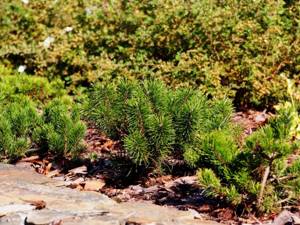
The crown does not require formation
Pumilio does not require formative pruning. Sanitary correction of green mass consists of removing dried branches.
Particular attention should be paid to the internal space of the crown so that there are no dead shoots left in it. The procedure is usually carried out until the kidneys open.
Preparing for winter
In its adult state, mountain pine can withstand frosts down to -46°. Young specimens, on the contrary, are extremely sensitive to low temperatures and need shelter during the first year of life. Agrofibre or spruce spruce branches are used for it.
Additionally, the soil is mulched with a layer of at least 7 cm in thickness. The exception is regions where in winter the temperature does not fall below 0°.
If the shrub grows in an area with harsh conditions, the crop must be provided with shelter for the next year. In climate zone 2, the event is carried out for up to 10 years.
Growing conditions
Mountain pine Pumilio grows best on sandy and loamy soils with average fertility, but is quite tolerant of other types of soil, including rocky and calcareous. The only limitations are high compaction and severe waterlogging. The bush does not tolerate long periods of stagnation of water. Therefore, the best option is to use drained soil for planting. Mountain pine is undemanding in terms of humidity, acidity, salinity, content of nutrients and other physical and chemical parameters of the soil. It is quite tolerant of light soil compaction.
The plant is highly resistant to frost and drought, but does not tolerate shade. However, Pumilio's sensitivity to low light is lower than that of ordinary pine. Another advantage of this coniferous bush is its ability to adapt to the polluted air of an urban environment.
Features of planting and care
Compared to many other types of ornamental plants, including conifers, in the case of the mountain Pumilio pine, planting and care require much less effort. The reason for this is the slow growth and unpretentiousness of this shrub. Pumilio does not require regular painstaking care and special gardening skills. You just need to know a few basic rules so that the pine tree takes root on the site and develops well. Pumilio requires the most attention in the first 2-3 years of growth.
For planting mountain pine, the best soil mixture is turf soil and sand (or clay) in a 2:1 ratio. When placing a seedling in heavy, dense soil, drainage made of expanded clay, sand or gravel must be laid at the bottom of the hole. The same must be done if there is a phenomenon of rising groundwater on the site. Drainage in this case prevents moisture stagnation in the root zone. If the soil is highly acidic, it is recommended to lime the soil.
The depth and width of the planting hole should be twice the corresponding dimensions of the seedling's root system. The plant must be placed in the hole so that the root collar is no lower than ground level. To do this, you need to pour the prepared soil layer onto the bottom of the hole until the seedling is in the desired position, then completely fill it to the top. The root collar can even be left a little higher with the expectation that the soil will compact and settle over time.
After planting, mountain pine must be watered by wetting the needles themselves with water. It is advisable to compact and mulch the soil around the seedling. Further care comes down to feeding, watering and protective measures necessary for a young, immature plant in the first 3 years of life.
The decorative side of growing involves pruning shoots to give the crown a beautiful shape. What is especially valuable is that Pumilio tolerates mechanical shortening of branches well. As a result, the crown becomes denser, rounder and more lush.
Landing
With the right location, Mugo Pumilio will not cause any particular difficulties or hassle in caring for it.
The best option would be soils with moderate fertility, well-drained. However, it must be taken into account that groundwater located close to the surface and systematic soil closure have a detrimental effect on the health of the crop.
An important nuance when choosing a place of residence is the degree of illumination. Culture loves to soak up the gentle rays of the sun.
Selection of seedlings
It is better to buy a seedling in specialized nurseries, while following a number of nuances regarding the appearance of the plant.
Preference should be given to specimens that:
- closed root system, not visible through the drainage holes of the container;
- crown, not exceeding in projection the size of an earthen clod;
- apparently healthy branches and a well-moistened substrate (it is not recommended to buy plants with needles that are falling off or have changed color, which is the main sign of a disease or complete death of the pine tree).
Preparing the site
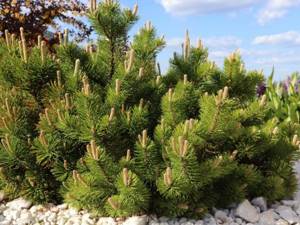
The plant is easy to care for
The planting hole is dug taking into account the location of the plant’s earthen clod in it and the required drainage layer, which ideally reaches 20 cm in thickness. The average proportions of the hole are 70 cm deep and 1.5 m wide.
If the site is dominated by chernozem or imported substrate, you will have to compose the soil mixture yourself. To do this, combine clay, river sand and turf soil, add 200-300 g of lime.
It would not be superfluous to add 1 bucket of humus (exclusively leafy, and not obtained from livestock waste products) or nitroammophoska in the amount of 100-150 g.
Landing technology
- A drainage layer of crushed brick or pebbles is placed in a hole prepared 2 weeks in advance.
- Fill in part of the substrate. Place the seedling in the center so that the neck is flush with the surface.
- Distribute the remaining soil. Compacted.
- Watered.
- Mulching.
Recommendations for cultivation
The first important part of growing mountain pine is purchasing a seedling, which should preferably be done in a proven, qualified nursery in the same region in which it is planned to plant. In this case, the plant will already be acclimatized.
When purchasing, gardeners recommend choosing seedlings with a closed root system, that is, placed in pots or earthen containers. In this case, the mycorrhiza formed on the roots will remain intact and will help the pine tree to strengthen and develop in a new area. Accordingly, when planting, you cannot separate the roots from the container soil.
For planting, you should choose a sunny area. Partial shade is also acceptable, although it will significantly delay the growth of Pumilio. The seedling will not take root in complete shade. Despite the light-loving plant, in the first 3 years of its development in winter and autumn, it is advisable to protect the needles from direct sunlight to prevent burns.
It is optimal to water Pumilio mountain pine three times per season in a volume of 15-20 liters. Mixtures for coniferous plants are perfect as a nutritional supplement. However, they must be used with caution. Gardeners do not recommend overfeeding Pumilio with nitrogen and organic matter.
Diseases and pests

Infections can affect the plant in autumn
The peak development of sores in the mountain pine Pumilio occurs in the autumn, when the weather outside is persistently damp and cold. These conditions are ideal for rust to appear.
Signs of damage: the formation of numerous yellow or red spots on the trunk and shoots.
The infection quickly spreads to other nearby trees and bushes. Therefore, you need to act urgently - remove damaged areas on weak bushes and treat the crown with a solution of copper sulfate or Ridomil Gold. Heavily infected specimens should be disposed of and burned.
For prevention, it is better to plant pine needles away from birch trees, avoid dense plantings, thin out the above-ground parts in a timely manner and remove organs injured by the fungus.
Of the parasites, this plant is plagued by the subbark bug, which sucks the juices from the stems and leads to their drying out and death. For control and prevention, insecticides are used - Actellik, Aktaru, Enzhio. Spraying is carried out in early spring and autumn.
To cope with aphids, spider mites, scale insects and sawflies, you will need to treat the crown and soil around the trunk three times with Aktara, Skor or Fundazol.
Regular removal of weeds, loosening the soil, adherence to the planting scheme and periodic inspection for signs of damage will help prevent the invasion of parasites.
Transfer
When transplanting mountain pine, several important rules must be taken into account:
- carry out the procedure in the spring or early autumn;
- the optimal age of the sample should be 3-5 years;
- the seedling must be completely healthy;
- the difference between the previous conditions in which the plant was located and the new ones should be minimal (then the sample will take root better).
In winter, transplantation of mature adult specimens is allowed.
Reproduction of Pumilio pine
Pumilio pine can be propagated in three ways:
- seeds;
- cuttings;
- grafting cuttings.
The first method is the longest, most labor-intensive and impractical. It is based on stratification and seed planting. With this method, there is a high probability of losing the varietal qualities of the mother plant, and the resulting shoot may not take root, so it is better to propagate pine by cuttings.
The material for cuttings should be mature, healthy Pumilio bushes. It is advisable to harvest in the spring. The cuttings are planted in pots with previously prepared soil. To speed up the development of pine trees, growth stimulants can be added to irrigation water. The seedling grown from the cuttings is transplanted into the ground.
Reproduction methods
Pumilio can be propagated by seeds, cuttings or grafting. Experienced gardeners sometimes grow seedlings from seeds. However, the effect of this method is always unpredictable. Seedlings obtained from seeds may not retain maternal characteristics. Sometimes the seeds do not germinate at all. Seed germination may take several years. Vaccinations are a long and labor-intensive process. The result also does not always satisfy gardeners.
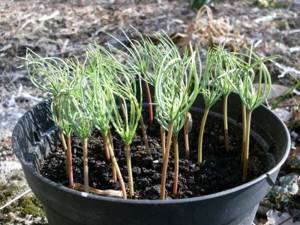
The most common and effective method is propagation by cuttings:
- A shoot with bark is cut off from a young shoot.
- The cuttings are placed in water for 3 hours, then in a solution of a growth stimulator (the time depends on the type of drug and is indicated in the instructions).
- The shoot is planted in the ground in a greenhouse.
- To increase the speed of rooting, create insulating litter.
- In autumn, the seedling moves to open ground.

